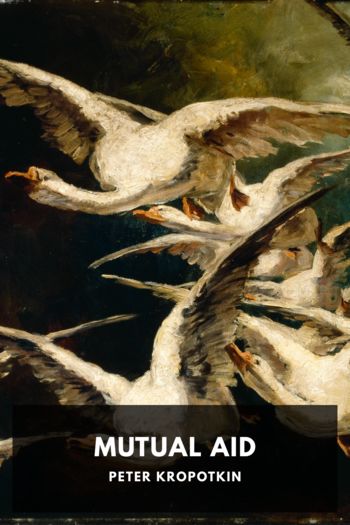Mutual Aid, Peter Kropotkin [fiction novels to read .txt] 📗

- Author: Peter Kropotkin
Book online «Mutual Aid, Peter Kropotkin [fiction novels to read .txt] 📗». Author Peter Kropotkin
“Chacun s’en est accommodé selon sa bienséance … on les a partagés … pour dépouiller les communes, on s’est servi de dettes simulées” (Edict of Louis XIV, of 1667, quoted by several authors. Eight years before that date the communes had been taken under State management). ↩
“On a great landlord’s estate, even if he has millions of revenue, you are sure to find the land uncultivated” (Arthur Young). “One-fourth part of the soil went out of culture;” “for the last hundred years the land has returned to a savage state;” “the formerly flourishing Sologne is now a big marsh;” and so on (Théron de Montaugé, quoted by Taine in Origines de la France Contemporaine, tome i, p. 441). ↩
A. Babeau, Le Village sous l’Ancien Régime, 3e édition. Paris, 1892. ↩
In Eastern France the law only confirmed what the peasants had already done themselves. See my work, The Great French Revolution, chaps. xlvii and xlviii, London (Heinemann), 1909. ↩
After the triumph of the middle-class reaction the communal lands were declared (August 24, 1794) the States domains, and, together with the lands confiscated from the nobility, were put up for sale, and pilfered by the bandes noires of the small bourgeoisie. True that a stop to this pilfering was put next year (law of 2 Prairial, An V), and the preceding law was abrogated; but then the village Communities were simply abolished, and cantonal councils were introduced instead. Only seven years later (9 Prairial, An XII), i.e. in 1801, the village communities were reintroduced, but not until after having been deprived of all their rights, the mayor and syndics being nominated by the Government in the 36,000 communes of France! This system was maintained till after the revolution of 1830, when elected communal councils were reintroduced under the law of 1787. As to the communal lands, they were again seized upon by the State in 1813, plundered as such, and only partly restored to the communes in 1816. See the classical collection of French laws, by Dalloz, Répertoire de Jurisprudence; also the works of Doniol, Dareste, Bonnemere, Babeau, and many others. ↩
This procedure is so absurd that one would not believe it possible if the fifty-two different acts were not enumerated in full by a quite authoritative writer in the Journal des Economistes (1893, April, p. 94), and several similar examples were not given by the same author. ↩
Dr. Ochenkowski, Englands wirthschaftliche Entwickelung im Ausgange des Mittelalters (Jena, 1879), pp. 35 seq., where the whole question is discussed with full knowledge of the texts. ↩
Nasse, Über die mittelalterliche Feldgemeinschaft und die Einhegungen des XVI. Jahrhunderts in England (Bonn, 1869), pp. 4, 5; Vinogradov, Villainage in England (Oxford, 1892). ↩
Fr. Seebohm, The English Village Community, 3rd ed., 1884, pp. 13–15. ↩
“An examination into the details of an Enclosure Act will make clear the point that the system as above described [communal ownership] is the system which it was the object of the Enclosure Act to remove” (Seebohm, The English Village Community, 3rd ed., 1884, p. 13). And further on, “They were generally drawn in the same form, commencing with the recital that the open and common fields lie dispersed in small pieces, intermixed with each other and inconveniently situated; that diverse persons own parts of them, and are entitled to rights of common on them … and that it is desired that they may be divided and enclosed, a specific share being let out and allowed to each owner” (p. 14). Porter’s list contained 3,867 such Acts, of which the greatest numbers fall upon the decades of 1770–1780 and 1800–1820, as in France. ↩
In Switzerland we see a number of communes, ruined by wars, which have sold part of their lands, and now endeavour to buy them back. ↩
A. Buchenberger, “Agrarwesen und Agrarpolitik,” in A. Wagner’s Handbuch der politischen Oekonomie, 1892, Band i, pp. 280 seq. ↩
G. L. Gomme, “The Village Community, with special reference to its Origin and Forms of Survival in Great Britain” (Contemporary Science Series), London, 1890, pp. 141–143; also his Primitive Folkmoots (London, 1880), pp. 98 seq. ↩
“In almost all parts of the country, in the Midland and Eastern counties particularly, but also in the west—in Wiltshire, for example—in the south, as in Surrey, in the north, as in Yorkshire—there are extensive open and common fields. Out of 316 parishes of Northamptonshire 89 are in this condition; more than 100 in Oxfordshire; about 50,000 acres in Warwickshire; in Berkshire half the county; more than half of Wiltshire; in Huntingdonshire out of a total area of 240,000 acres 130,000 were commonable meadows, commons, and fields” (Marshall, quoted in Sir Henry Maine’s Village Communities in the East and West, New York edition, 1876, pp. 88, 89). See also Dr. G. Slater’s The English Peasantry and the Enclosure of Common Fields, London, 1907. ↩
Ibid. p. 88; also Fifth Lecture. ↩
In quite a number of books dealing with English country life which I have consulted I have found charming descriptions of country scenery and the like, but almost nothing about the daily life and customs of the labourers.





Comments (0)